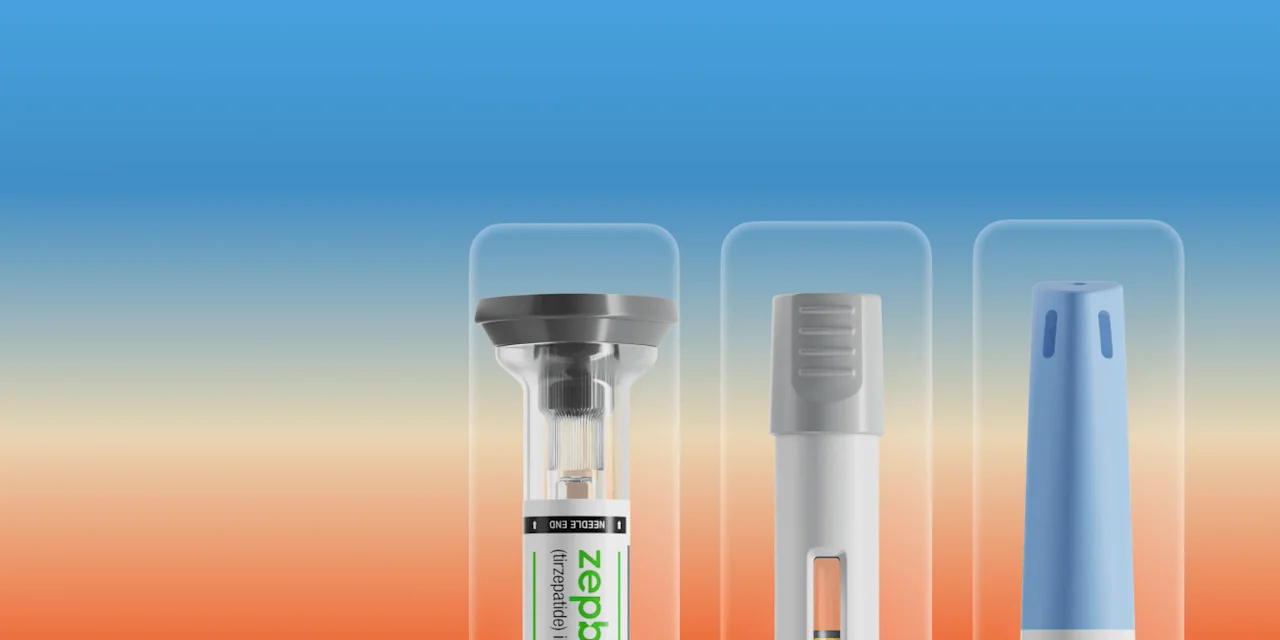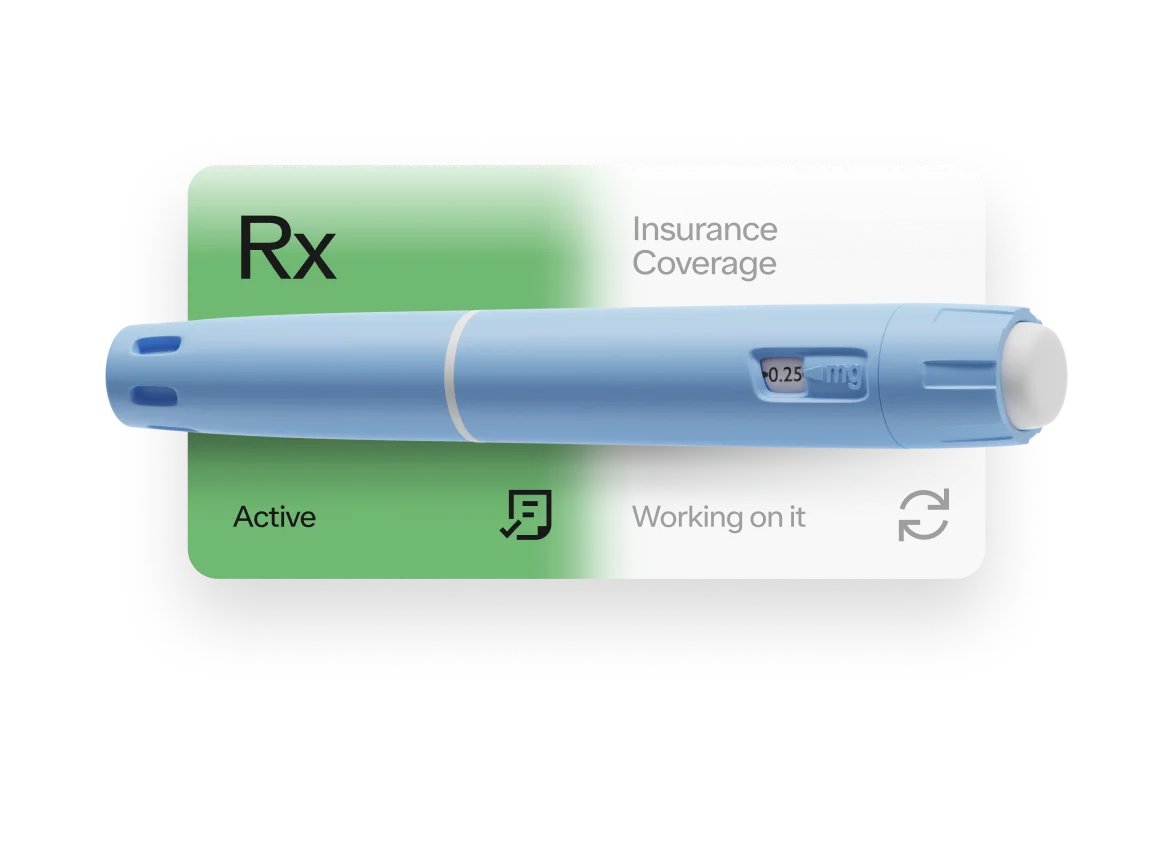Key takeaways
Ozempic is not insulin; it’s a GLP-1 receptor agonist that regulates blood sugar levels in people with type 2 diabetes. It helps the body release insulin only when blood sugar is high.
Insulin is a natural hormone essential for type 1 diabetes and later-stage type 2 diabetes; Ozempic cannot replace it.
While different, Ozempic and insulin can be prescribed together in type 2 diabetes for better blood sugar control.
Here's what we'll cover
Here's what we'll cover
Here's what we'll cover
Key takeaways
Ozempic is not insulin; it’s a GLP-1 receptor agonist that regulates blood sugar levels in people with type 2 diabetes. It helps the body release insulin only when blood sugar is high.
Insulin is a natural hormone essential for type 1 diabetes and later-stage type 2 diabetes; Ozempic cannot replace it.
While different, Ozempic and insulin can be prescribed together in type 2 diabetes for better blood sugar control.
Is Ozempic (semaglutide) insulin? No, Ozempic is not insulin. Instead, it mimics the GLP-1 hormone to help your body release natural insulin when blood sugar is high. This helps keep blood sugar levels under control. Ozempic can also help slow gastric emptying and curb appetite.
Insulin, by contrast, is the hormone that actually lowers blood (glucose) sugar. It’s produced by pancreas, and it moves glucose from the bloodstream into cells for energy. When your body doesn’t make enough insulin or cannot use it properly, blood sugar levels rise. Healthcare providers may prescribe insulin injections in these cases.
Ozempic and insulin are both injectable medications that help manage diabetes, but they are not the same thing.
What is Ozempic and how does it work?
Ozempic is the brand name for the drug semaglutide. This medication acts like the hormone GLP-1. After you eat, GLP-1 tells your pancreas to release insulin and helps lower glucagon, a hormone that raises blood sugar.
Ozempic works in several ways:
It helps the pancreas release insulin only when blood sugar is high.
It lowers glucagon, a hormone that can make the liver release too much sugar.
It slows down how quickly food leaves your stomach, which helps prevent big spikes in blood sugar after meals.
It works in the brain to reduce appetite and cravings, often leading to weight loss.
Beyond its role in managing blood sugar, the US Food and Drug Administration (FDA) has also approved Ozempic to reduce the risk of serious cardiovascular problems in people with type 2 diabetes and cardiovascular disease.
Studies show semaglutide is better than other diabetes medicines, such as DPP-4 inhibitors, for lowering cardiovascular risk in people with type 2 diabetes and atherosclerosis. Studies have also found that Wegovy (another brand name version of semaglutide) 2.4 mg weekly reduced the risk of heart attack, stroke, and death from cardiovascular causes in people with heart disease and overweight or obesity but without diabetes, and the FDA has approved it for this purpose.
Research is ongoing to explore whether semaglutide could play a future role in other areas of health as well.
What is insulin and how does it work?
Insulin is a peptide hormone released by the pancreas. It regulates blood glucose by helping cells take in and use sugar. Healthcare providers prescribe insulin when the body doesn’t make enough or when it needs more than it can produce.
Insulin works by binding to receptors on cell membranes. This binding triggers glucose transporters to move to the cell surface and bring glucose from the blood into the cells.
In the liver, insulin promotes glycogen storage and reduces glucose production. In fat tissue, it promotes fat storage and stops fat breakdown. And in muscle, it promotes glycogen and protein synthesis and reduces protein breakdown.
Insulin therapy has several main uses:
For type 1 diabetes, where the immune system destroys beta cells, insulin is always required.
In later-stage type 2 diabetes, when cells resist insulin, the pancreas can no longer keep up.
For maturity-onset diabetes of the young (MODY), a genetic condition that impairs insulin secretion.
In gestational diabetes, when diet and exercise do not control blood sugar.
Insulin comes in different types based on how long it acts. Rapid-acting insulin works almost right away and is taken just before meals. Short-acting insulin takes a little longer to start working and is also used around mealtimes. Long-acting insulin, like glargine or detemir, provides steady background glucose control for a full day with just one dose.
You can take insulin in several ways. Most patients inject it under the skin using syringes, pens, or pumps. In hospitals, insulin can be given through intravenous infusion for emergencies such as diabetic ketoacidosis or severe hyperkalemia.
Ozempic vs insulin: what are the differences?
If you’re still wondering whether Ozempic is the same as insulin, or whether Ozempic a type of insulin, here’s a simple breakdown to help clarify:
| Ozempic (semaglutide) | |
|---|---|---|
How it works | Stimulates the body’s own insulin release only when blood sugar is high; lowers glucagon and slows gastric emptying | Directly lowers blood glucose by moving it into cells |
Is there a risk of low blood sugar? | Low risk (effects depend on blood sugar level) | High risk (acts regardless of blood sugar level) |
Why do you use it? | Improves blood sugar in adults with type 2 diabetes (with lifestyle changes) Lowers cardiovascular risk in those with type 2 diabetes and heart disease Reduces kidney complications in type 2 diabetes with kidney disease May aid weight management (off-label). | Essential for type 1 diabetes Used in type 2 diabetes when the body can’t make enough insulin or use it properly |
How do you administer it? | Once-weekly injection under the skin | Daily or multiple injections under the skin; can also be given by IV in hospital settings |
Can you take Ozempic and insulin at the same time?
Yes, you may be able to take Ozempic and insulin together if prescribed. This combination is sometimes used for type 2 diabetes when one medicine is not enough. Together, they can improve blood sugar control and may reduce required insulin doses. Always follow medical guidance to lower the risks of low blood sugar.
In the SUSTAIN 5 clinical trial, people with type 2 diabetes who added semaglutide to their daily insulin saw their average blood sugar (A1C) drop by about 1.4 to 1.8 points over 30 weeks. Those who stayed on insulin alone saw little to no improvement.
People taking both medicines also lost an average of about 8–14 pounds, while those on insulin without semaglutide lost only about three pounds. Many of them were also able to reduce the amount of insulin they needed once semaglutide was added.
What to expect if taking them together
If you’re prescribed both Ozemic and insulin, here’s what to know:
Separate shots: Ozempic and insulin should never be mixed in the same syringe. They must be injected separately.
Same area, different spots: You can inject them in the same general area of your body, like the stomach or thigh, but not right next to each other.
Safety considerations
Based on the prescribing information for Ozempic and findings from the SUSTAIN-5 trial, here’s what to keep in mind if you’re taking Ozempic with insulin:
Low blood sugar (hypoglycemia): The risk of low blood sugar is higher when Ozempic is used together with insulin. To help reduce this risk, your healthcare provider might lower the insulin dose when starting Ozempic. They may also want you to check your blood sugar at home more often than usual to watch for low readings.
Digestive side effects: Nausea, vomiting, and diarrhea are the most common side effects of Ozempic. Nausea can also be a sign of hypoglycemia, which may happen more often when it’s combined with insulin. In the clinical trial, digestive issues were the main reason some people stopped Ozempic treatment.
Which medication is right for you?
Ozempic and insulin are used in different ways, and no single drug is “better” for everyone. Treatment is personalized, guided by your healthcare provider, and often adjusted over time. Here’s what to keep in mind:
Type 1 diabetes considerations
Insulin is always required for type 1 diabetes because the pancreas produces little to no insulin. No currently available GLP-1 receptor agonist, including Ozempic, is FDA-approved to manage type 1 diabetes.
There has been research on using semaglutide in people with overweight or obesity along with type 1 diabetes. A study found that people on both treatments had better weight control and improved blood sugar metrics. However, this use is considered off-label and not part of FDA-approved treatment.
Type 2 diabetes considerations
Treatment for type 2 diabetes can involve either Ozempic, insulin, or both, depending on the condition's severity. Ozempic (semaglutide) can be used in addition to diet and exercise to improve blood sugar control in adults with type 2 diabetes.
Insulin is typically prescribed when the pancreas can no longer make enough insulin to control blood sugar. Some people with obesity may also be prescribed a higher 2.4 mg semaglutide dose (Wegovy) for weight management.
In some cases, both medications may be prescribed together if one treatment alone is not enough to keep blood sugar in range. This combination can also allow for lower insulin doses while maintaining good glucose control.
Factors your provider will consider
When deciding between Ozempic, insulin, or both, here’s what providers take into account:
Type of diabetes: Insulin is always needed in type 1 diabetes.
Stage of disease: In type 2 diabetes, insulin may be added if the pancreas can’t make enough insulin over time.
Risk of low blood sugar: Using Ozempic with insulin increases the chance of low blood sugar, so doses may need adjusting.
Kidney and liver health: Insulin doses may need to be adjusted if the kidneys or liver aren’t working well.
History of low blood sugar: If someone has had hypoglycemic episodes before, blood sugar monitoring and insulin adjustments become especially important.
Drug interactions and electrolytes: Some medicines and conditions (like frequent vomiting or diarrhea) can cause low potassium, which needs extra caution with insulin.
Allergies to ingredients: Insulin is not suitable for people sensitive to cresol (an ingredient in some insulin products). Ozempic should not be used by anyone with a serious allergy to semaglutide or its ingredients.
Risk of thyroid tumors: Ozempic should not be used by people with a personal or family history of medullary thyroid carcinoma (MTC) or multiple endocrine neoplasia syndrome type 2 (MEN 2). Tumors have been observed in animals, but human risk is unclear.
Bottom line: is Ozempic insulin?
Is Ozempic considered insulin? The answer is no. Although insulin and Ozempic are often mentioned together because they both help manage diabetes, they’re very different in how they work and when they’re used.
Insulin is required in many cases: It’s essential for type 1 diabetes and often needed in later stages of type 2 diabetes.
Ozempic is an option for type 2 diabetes: It’s prescribed for blood sugar control, cardiovascular or kidney-related risk reduction, and sometimes off-label for weight management.
They can be used together: In some cases, Ozempic is added to insulin therapy for type 2 diabetes, which can improve blood sugar control and reduce insulin requirements.
We can help answer questions like, is Ozempic insulin? A healthcare provider can then guide whether Ozempic, insulin, or both are right for you based on your diabetes type, overall health, and treatment goals.
Frequently asked questions (FAQs)
Is semaglutide insulin?
No, semaglutide (the active ingredient in Ozempic) is not insulin. It mimics a natural hormone (GLP-1) to help manage blood sugar, but it doesn’t replace the hormone insulin itself.
Does Ozempic replace insulin?
No, Ozempic doesn’t replace insulin for people who need it. Clinical comparisons of the differences between Ozempic and insulin highlight their unique roles in managing diabetes.
If you have type 1 diabetes or later-stage type 2 diabetes, you will likely still need insulin. Always follow your healthcare provider’s guidance before making changes.
Can I switch from insulin to Ozempic?
No, you should not switch from insulin to Ozempic on your own. If you’re already using insulin, your healthcare provider may adjust your insulin dose when starting Ozempic to lower the risk of low blood sugar. Any changes to insulin should only be made under close supervision of your healthcare provider.
Will I need insulin if Ozempic stops working?
Yes, you might need insulin if Ozempic stops working, but not necessarily. If Ozempic isn’t enough to control blood sugar, other treatments may be an option.
People with type 2 diabetes often start with metformin and then might add other oral medications. If those fail, treatment can progress to injectable options such as Ozempic. If those aren’t enough, insulin may be considered.
DISCLAIMER
If you have any medical questions or concerns, please talk to your healthcare provider. The articles on Health Guide are underpinned by peer-reviewed research and information drawn from medical societies and governmental agencies. However, they are not a substitute for professional medical advice, diagnosis, or treatment.
Ozempic Important Safety Information: Read more about serious warnings and safety info.
GLP-1 Important Safety Information: Read more about serious warnings and safety info.
References
Canadian Agency for Drugs and Technologies in Health. (2019). Clinical review report: Semaglutide (Ozempic) (Novo Nordisk Canada Inc.): Indication: For the treatment of adult patients with type 2 diabetes mellitus to improve glycemic control, in combination with metformin (second-line treatment), and in combination with metformin and sulfonylurea (third-line treatment). Canadian Agency for Drugs and Technologies in Health. Retrieved from https://www.ncbi.nlm.nih.gov/books/NBK544009/
Chao, A. M., Tronieri, J. S., Amaro, A., et al. (2023). Semaglutide for the treatment of obesity. Trends in Cardiovascular Medicine, 33(3), 159–166. doi: 10.1016/j.tcm.2021.12.008. Retrieved from https://pmc.ncbi.nlm.nih.gov/articles/PMC9209591/
DiMeglio, L. A., Evans-Molina, C., & Oram, R. A. (2018). Type 1 diabetes. Lancet, 391(10138), 2449–2462. doi: 10.1016/S0140-6736(18)31320-5. Retrieved from https://pubmed.ncbi.nlm.nih.gov/29916386/
Donner, T. & Muñoz, M. (2012). Update on insulin therapy for type 2 diabetes. The Journal of Clinical Endocrinology and Metabolism, 97(5), 1405–1413. doi: 10.1210/jc.2011-2202. Retrieved from https://pubmed.ncbi.nlm.nih.gov/22442275/
Garg, S. K., Kaur, G., Haider, Z., et al. (2024). Efficacy of Semaglutide in Overweight and Obese Patients with Type 1 Diabetes. Diabetes Technology & Therapeutics, 26(3), 184–189. doi: 10.1089/dia.2023.0490. Retrieved from https://pubmed.ncbi.nlm.nih.gov/38444317/
Hoffman, L.S., Fox, T.J., Anastasopoulou, C., et al. (2023). Maturity Onset Diabetes in the Young. StatPearls. Retrieved on Sep. 16, 2025 from https://www.ncbi.nlm.nih.gov/books/NBK532900/
Inzucchi, S.E., Tan, X., Liang, Y., et al. (2025). Cardiovascular Events in Adults with Type 2 Diabetes and ASCVD Initiating Once-Weekly Semaglutide vs DPP-4is in the USA. Diabetes Therapy, 16(2), 187-203. doi: 10.1007/s13300-024-01678-4. Retrieved from https://pubmed.ncbi.nlm.nih.gov/39688779/
Jahagirdar, D. & Mahood, Q. (2023). Semaglutide for type 2 diabetes (2 mg): CADTH health technology review. Canadian Agency for Drugs and Technologies in Health. Retrieved from https://www.ncbi.nlm.nih.gov/books/NBK598216/
Kommu, S. & Whitfield, P. (2024). Semaglutide. StatPearls. Retrieved on Sep. 16, 2025 from https://www.ncbi.nlm.nih.gov/books/NBK603723/
Lincoff, A. M., Brown-Frandsen, K., Colhoun, H. M., et al. (2023). Semaglutide and Cardiovascular Outcomes in Obesity without Diabetes. New England Journal of Medicine, 389(24), 2221–2232. doi: 10.1056/NEJMoa2307563. Retrieved from https://pubmed.ncbi.nlm.nih.gov/37952131/
Meier, J. J. (2012). GLP-1 receptor agonists for individualized treatment of type 2 diabetes mellitus. Nature Reviews. Endocrinology, 8(12), 728–742. doi: 10.1038/nrendo.2012.140. Retrieved from https://pubmed.ncbi.nlm.nih.gov/22945360/
Patti, A. M., Giglio, R. V., Pafili, K., et al. (2018). Pharmacotherapy for gestational diabetes. Expert Opinion on Pharmacotherapy, 19(13), 1407–1414. doi:10.1080/14656566.2018.1509955. Retrieved from https://pubmed.ncbi.nlm.nih.gov/30136869/
Pérez, A., Ramos, A., & Carreras, G. (2020). Insulin Therapy in Hospitalized Patients. American Journal of Therapeutics, 27(1), e71–e78. doi: 10.1097/MJT.0000000000001078. Retrieved from https://pubmed.ncbi.nlm.nih.gov/31833876/
Posner, B. I. (2017). Insulin Signalling: The Inside Story. Canadian Journal of Diabetes, 41(1), 108–113. doi: 10.1016/j.jcjd.2016.07.002. Retrieved from https://pubmed.ncbi.nlm.nih.gov/27614806/
Rodbard, H. W., Lingvay, I., Reed, J., et al. (2018). Semaglutide Added to Basal Insulin in Type 2 Diabetes (SUSTAIN 5): A Randomized, Controlled Trial. The Journal of Clinical Endocrinology And Metabolism, 103(6), 2291–2301. doi: 10.1210/jc.2018-00070. Retrieved from https://pmc.ncbi.nlm.nih.gov/articles/PMC5991220/
Thota, S. & Akbar, A. (2023). Insulin. StatPearls. Retrieved on Sep. 16, 2025 from https://www.ncbi.nlm.nih.gov/books/NBK560688/
U.S. Food and Drug Administration (FDA-a). (2025). Highlights of prescribing information: Ozempic (semaglutide) injection, for subcutaneous use. Retrieved from https://www.accessdata.fda.gov/drugsatfda_docs/label/2025/209637s025lbl.pdf
U.S. Food and Drug Administration (FDA-b). (2025). Prescribing information: Wegovy (semaglutide) injection, for subcutaneous use. Retrieved from https://www.accessdata.fda.gov/drugsatfda_docs/label/2025/215256s024lbl.pdf
Wilcox, G. (2005). Insulin and insulin resistance. The Clinical Biochemist Reviews, 26(2), 19-39. Retrieved from https://pubmed.ncbi.nlm.nih.gov/16278749/














